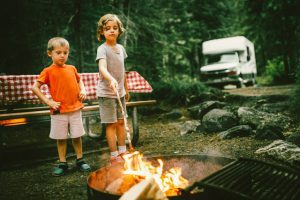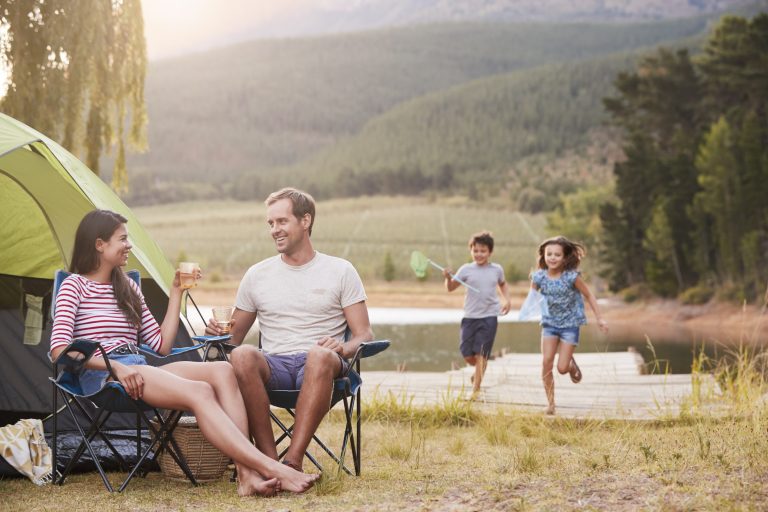Planning your family’s first-ever camping trip? Forgive the tent-related pun, but you might be feeling like the stakes are high, with the trip’s success resting entirely on you. However, there’s no need to (brace yourself for tent pun #2) get in a flap about it! We’re here to help with practical tips to ensure you have a tent full of happy campers from start to finish. Read on for 20 tips for first-time camping families.
Before you go
Limit the distance.
Don’t venture too far on the first trip. If you keep your travel time reasonable, it will be easier to head home if there is bad weather or someone becomes sick or injured. Search for a nearby location with convenient amenities and family-friendly features like a beach or playground.
Talk about it. Since this will be a new experience for some (or all) family members, chat about what to expect. Camping website TheCampCorner suggests talking about things that will be the same (spending time together and eating meals as a family) and things that will be different (sleeping in a tent or trailer and cooking food over a fire). If you have an only child, consider inviting a friend or cousin for company.
Set parameters for screen time. If one of your camping goals is to “unplug” from your devices for a few days, make this clear in advance. Explain to your kids why it will be valuable to connect to nature (instead of apps) for a few days. Or, maybe you have a specific vision for technology use (for example, during the drive, to keep little ones occupied during set-up and tear-down, or to take photos and videos). Whatever your plans, communicate them openly so kids know what to expect.
Plan group activities. Ask the kids to Google campfire stories, songs and games for around the fire. If you’re a musical type who is bringing a guitar, throw in some simple background instruments, like shakers, harmonicas and kazoos. You can also re-connect as a family with an old-school deck of cards or a travel board game.
Build the menu. Ask the kids for input, and include some food items you wouldn’t typically have at home (my kids go bonkers for those mini individual boxes of “treat” cereal). Plan simple, wholesome meals you know everyone will like, and have a few extra ideas in reserve. Bonus mealtime tip: if you have access to a mesh canopy tent or picnic shelter, they provide welcome protection from the elements (and pesky insects) while eating.

Pack practical clothes. When camping, function takes priority over fashion. Pack durable, versatile items that can be worn in layers. Everything should be easily washable, since it will likely end up full of sand and smelling like campfire smoke. In case of rain, make sure everyone has a water-resistant jacket, splash pants and rubber boots.
Bring “quiet time” supplies. There will be moments where everyone needs to rest or regroup, so each child should have a small backpack with a few individual activities. Give older kids the responsibility of prepping this on their own. Pre-check the bags and slip in a little surprise to be discovered later, like a word search, sticker book, comic, drawing pad, or package of sports cards.
Choose comfort objects carefully. It’s a classic packing dilemma: do you bring your child’s favourite toy or stuffed animal, since they claim they can’t function without it… or does that set up the potentially disastrous outcome of a treasured item being lost or damaged? One alternative is to identify a special “camping stuffy” for the trip — possibly a secondary one from their collection, or a “new” one from a thrift store. You can get extra creative and select an animal that is part of the local wildlife, like a moose, raccoon, or fox.
Get kid-specific gear. You may need a wearable carrier for your baby, a rugged stroller for your toddler (which can double as a high chair) or a kid-sized camp chair for your preschooler. You’ll also want to travel with your child’s medications, epi-pens or other health accessories.
Make a list. And check it twice, so nothing is forgotten or left behind. To guide you through the process, consult this comprehensive packing checklist from the experts at Mountain Equipment Company.
During
Put safety first. A fully stocked first aid kit is a must. At your campsite, be diligent about basic fire safety procedures, like these ones from Smokey the Bear. If boating or swimming are in your plans, wear lifejackets and observe the posted swimming guidelines. Store all sharp objects (such as axes, knives and fishing tackle) in securely fastened containers, and don’t leave them anywhere children can reach them.
Share the chores. Give kids age-appropriate roles to build their confidence. They can pitch in with jobs like zipping the tent entrance, setting up sleeping bags, and putting clean dishes in the picnic basket.
Stay organized. Designate a specific storage spot for important items like electronics or flashlights, using a container or hanging drawstring bag. For multiple items belonging to different family members (such as water bottles or headlamps), add name labels to avoid mix-ups.
Keep hands clean. An experienced camping friend told me: “You can never have too many hand wipes.” Set up an easily accessible “hygiene station” with a container of single-use wipes or a pump bottle of hand sanitizer. You can also use a small basin of water with soap and a quick-dry towel (a marvellous camping invention).
Explore and play. Camping is all about new experiences, so encourage everyone to keep an open mind. As it suggests in this list of family-friendly camping activities, let your kids tap into their creative side and discover that a stick is so much more than “just a stick.”
Maintain your sanity. In any new endeavor — including camping — there can be moments of unexpected stress. Have a pre-set signal with your spouse or partner, to be used when either one of you is feeling overwhelmed and needs a few minutes of privacy to breathe deeply and regroup. It might sound like an unnecessary measure, but it can be useful in the moment when you encounter a frustrating roadblock or glitch.
Reduce the pressure. You don’t have to do everything or see everything on the first trip. Customize the daily schedule (or non-schedule) to suit your family’s needs, resources, and energy levels. In the end, it’s about quality, not quantity.
Document the experience. Start an old-fashioned journal of stories, funny moments, bloopers, and quotable quotes. Or, for a more high-tech option, have your tween record a video diary or take pictures to be made into a slide show with music.
After
Shop smart. Take inventory of the gear you used and make a mental “wish list” of items to be added or upgraded. Then, watch for sales at the end of the season, so you can be opportunistic and purchase high quality equipment at a lower price.
De-brief. A few days after your return, have a “post-camping” chat at a family meal. Gather feedback from everyone, including the highlights and low-lights. Take notes of the things you learned and jot down some reminders and ideas for “next time.” In the end, that’s the goal: for the first camping trip to go well, so the family will be keen to do a second one.
Good luck, stay calm, and camp on!

